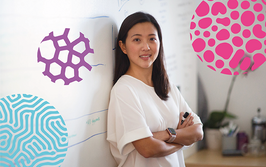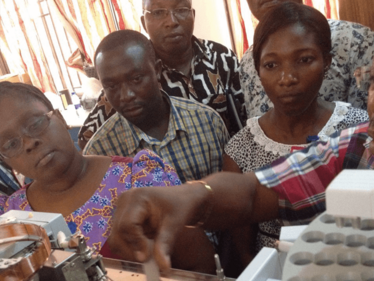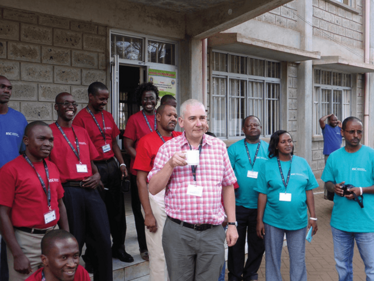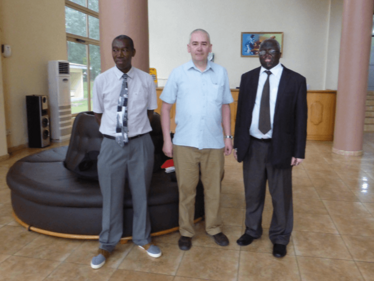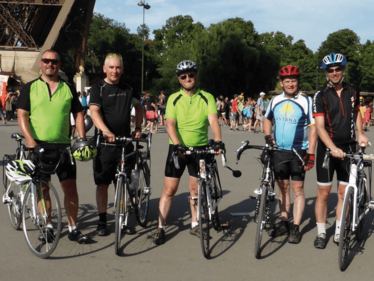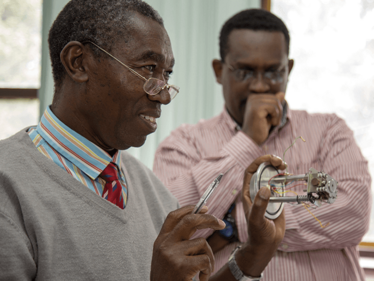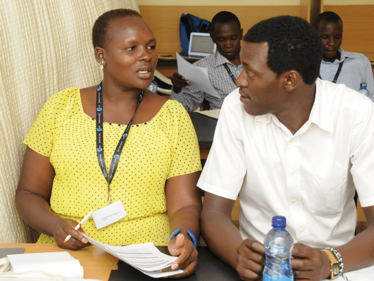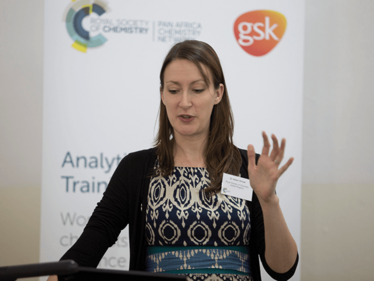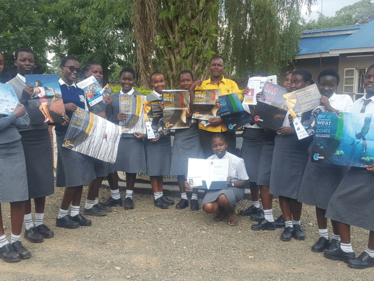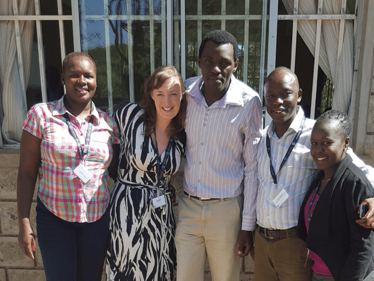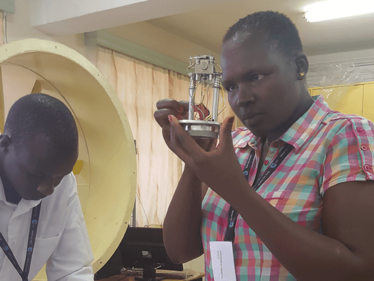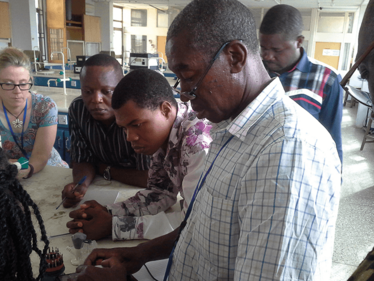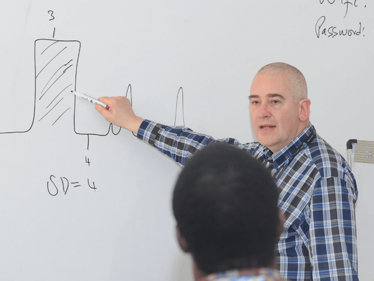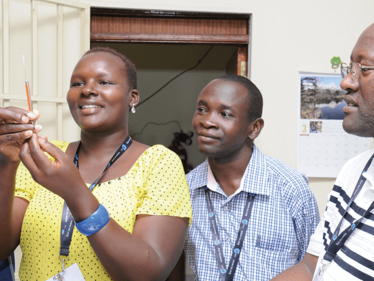
Analytical Science Sans Frontieres
How a cross-border collaboration is empowering the African analytical community – and making a vital impact.
Vulture Shock
By Steve Lancaster and Ngaio Richards
Vultures may not be the most beautiful of birds, but they fulfill a critical role in African ecosystems, and their declining numbers on the continent are a major concern. In India, the number of vultures has dropped by over 90 percent in the last 20 years or so, and Africa is going the same way – it’s alarming. One major reason is that farmers occasionally need to give their cattle non-steroidal anti-inflammatories (NSAIDs) – the veterinary version of Ibuprofen – so they can continue to work, pulling ploughs. These NSAIDs are very toxic to birds, so when farmers leave cattle carcasses out to be picked clean by the vultures – so they can use the bones to make fertilizer – the vultures eat the flesh and die. It’s resulting in big losses in the vulture population. There’s another reason too: farmers whose cattle are taken by large predatory mammals, such as lions, sometimes leave poisoned meat out to kill the lions, which kills the vultures as well.
In one of our first projects in collaboration with African scientists, we worked with Ngaio Richards, a PhD student using mass spectrometry to measure the metabolites of toxins in vulture feathers and talons. Obviously, if a dead vulture has been out in the African sun for any length of time, the flesh is not a viable sample, so it’s very difficult to analyze, but toxins can be analyzed in the feathers for some time after. We helped to develop methodology to measure these toxins, to build up a deeper understanding of why vultures are in danger of becoming extinct. These methods are now providing real forensic evidence. That, in turn, is feeding into an education program, so farmers and vets are much more aware of the need to be careful with prescriptions to animals – and also to be mindful that they’re poisoning more than lions and tigers.
One big problem? Vultures are not highly thought of, so it’s a hard sell – which can also be true of analytical science!
Whether political or geographical, financial or instrumental, each region has its own challenges. In many African countries, increasing student numbers and a dearth of instrumentation can mean little hands-on experience for the next generation of analytical scientists. But things are changing. Academics across the continent are increasingly teaming up with individuals, vendors and academic institutions in other parts of the world to reinvigorate teaching – a testament to the collaborative and supportive nature of the international analytical community. The ultimate goal? To create a well-funded and self-sufficient environment, where existing talent across the continent can be used to address key issues and deal with ‘real world’ problems.
We speak to scientists, students and the Royal Society of Chemistry to discover how the donation of an old GC-MS instrument has led to so much more...
FASTA Progress
In around 2005, my former lab-mate, Anthony Gachanja – now an academic in Nairobi (Jomo Kenyatta University), contacted me to ask if I could find someone willing to donate a GC-MS instrument. He explained that many teaching staff were unable to provide their undergraduates with ‘hands on’ experience using advanced analytical equipment; mass spectrometers were simply not available. In addition, scientists in African countries have traditionally had to send samples away for analysis – either to South Africa, Europe or America. So as well as providing a good means of teaching students, having such instruments in situ would allow teaching staff to run their own samples – and that’s really important.
I contacted Barry Nixon, who runs a company called Mass Spec Technologies, and he was able to donate one of their instruments; the lab was happy for it to go to a good home. We needed to raise about £3,000 to refurbish that instrument, ship it over to Nairobi and send an engineer over there to commission it. I was working at BP at the time, and they ran a ‘matched giving scheme’ – but we found out they could only double our money if we were a registered charity. So, in a nutshell, that’s how FASTA came about – we became a registered charity in 2006. We raised the funds through sponsored events, had them matched by BP and were able to send the instrument over and commission it. Barry and I then went over to Nairobi and set it up.
Charting a course
Since setting up the mass spec in Anthony’s lab, the Royal Society of Chemistry (RSC) has formed the Pan-African Chemistry Network (PACN), which works with universities, schools, scientists, teachers, and students to integrate African countries into international scientific networks. Training courses are a key part of the network, and I’m incredibly proud that the GC-MS training courses run by Anthony, Mathias Schafer (Cologne University) and me are perceived as the ‘jewel’ in the PACN crown.
We have now worked with around 200 chemists from all over Africa: mainly Kenya, Ethiopia, Uganda and Ghana, but people from as far afield as Nigeria and Egypt have also attended. It’s rewarding to see people learning and developing confidence. I’m passionate about sharing my knowledge and experience with others who are interested to learn – and the African scientists I have met are hungry to develop these skills.
Crucially, many of the people on the courses are lecturers from African universities, so they can pass their newfound skills and knowledge on to their own students, meaning that it’s not just the 200 people we have directly trained who benefit. Around 20–30 cited papers in peer-reviewed journals have come directly out of this course – so it’s really having an impact on analytical science in African countries.
Together with GSK, we aim to increase the number of courses from two to about 10 per year by 2018/2019. GSK is investing heavily in Africa, setting up manufacturing facilities there, so they need a cohort of highly-trained analytical scientists.
Raising awareness, improving lives
We are also working with fellow scientists on projects in other parts of Africa, with a view to facilitating education – and, most importantly, improving lives through analytical science research. For example, we collaborated with a PhD researcher who was focusing on forensic analysis of wildlife (see “Vulture Shock”).
The analytical science needs of Africa aren’t as emotionally stirring as starving children – and that’s how it should be. However, it does make it more difficult to raise money or awareness for analytical science projects. Many people don’t understand what – or how important – analytical science is; it is almost invisible to people beyond the field.
The RSC and Domino Printing Sciences have been absolutely fantastic in facilitating a lot of this work – they’ve supported us, funded us, and have provided a lot of admin and managerial input. PerkinElmer and Shimadzu have been good enough to donate instruments, and Mass Spec UK have donated secondhand instruments through Barry Nixon. We are also exploring ways which we can work with Agilent. And the project certainly couldn’t have grown without PACN, Syngenta and GSK. The passion of people on the ground is great, but without the backing of big organizations it’s hard to have the same impact.
And the original GC mass spec? It’s quite old but it’s still in use in Anthony’s lab in Nairobi. They’ve now got a couple of more modern instruments, but the original is still doing good service in teaching labs – all in all, it was a good investment!
Vulture Shock
By Steve Lancaster and Ngaio Richards
Vultures may not be the most beautiful of birds, but they fulfill a critical role in African ecosystems, and their declining numbers on the continent are a major concern. In India, the number of vultures has dropped by over 90 percent in the last 20 years or so, and Africa is going the same way – it’s alarming. One major reason is that farmers occasionally need to give their cattle non-steroidal anti-inflammatories (NSAIDs) – the veterinary version of Ibuprofen – so they can continue to work, pulling ploughs. These NSAIDs are very toxic to birds, so when farmers leave cattle carcasses out to be picked clean by the vultures – so they can use the bones to make fertilizer – the vultures eat the flesh and die. It’s resulting in big losses in the vulture population. There’s another reason too: farmers whose cattle are taken by large predatory mammals, such as lions, sometimes leave poisoned meat out to kill the lions, which kills the vultures as well.
In one of our first projects in collaboration with African scientists, we worked with Ngaio Richards, a PhD student using mass spectrometry to measure the metabolites of toxins in vulture feathers and talons. Obviously, if a dead vulture has been out in the African sun for any length of time, the flesh is not a viable sample, so it’s very difficult to analyze, but toxins can be analyzed in the feathers for some time after. We helped to develop methodology to measure these toxins, to build up a deeper understanding of why vultures are in danger of becoming extinct. These methods are now providing real forensic evidence. That, in turn, is feeding into an education program, so farmers and vets are much more aware of the need to be careful with prescriptions to animals – and also to be mindful that they’re poisoning more than lions and tigers.
One big problem? Vultures are not highly thought of, so it’s a hard sell – which can also be true of analytical science!
Empowering the Talent Pool
GC-MS is a powerful way to analyze a range of substances – it can be used in everything from environmental monitoring and food safety to forensic science and medicine. When we decided to develop the course program started by Anthony Gachanja and Steve Lancaster, we were in a very fortunate position, as the expertise and equipment already existed in Africa. However, there is still a distinct need to increase the number of African scientists and institutions who have the skills to fully benefit from this powerful analytical method. We knew we needed to scale up the volume and impact of these courses to benefit more people – and as of now, we are on target to train over 400 African scientists by 2020.
Ethiopia, Kenya, Ghana and Nigeria are all experiencing ongoing growth in the quality and quantity of scientific research taking place. These countries operate as ‘Hubs’, engaging with people from other countries in their regions. The Pan Africa Chemistry Network (PACN) has been based at these four Hubs for many years, and the universities have the people, equipment and facilities needed to host the courses. In 2016, the four courses have trained people from ten different countries, including Burkina Faso, Cameroon, Sudan, Tanzania and Uganda.
The Hubs are a vital part of this program. When Anthony Gachanja and Steve Lancaster started their small training program in Nairobi in 2006, budding analytical chemists traveled from across Africa to take part. Now that we have courses running across Africa, more people can attend the course in their home or neighboring country, limiting the travel required. We have worked hard to widen our advertising for the upcoming courses, to give as many people as possible the opportunity to be part of it. One big challenge we face is how to manage the demand for these courses; we get many more applications to attend than there are spaces available. However, we hope that over the coming five years we can start to meet that demand.
Widening horizons
The project is a partnership between the Royal Society of Chemistry’s Pan Africa Chemistry Network (PACN) and GSK. We have been keen to roll this program out across Africa for many years, and support from GSK has enabled us to do this. The PACN shares many objectives in common with GSK’s ambitions and investment in Africa. We are both working to ensure sustainable scientific development in Africa by equipping local scientists with the skills, knowledge and training they need. GSK supports their staff to engage in volunteer opportunities, and so far, five members of GSK staff have been confirmed as part of the project, sharing their specialist analytical expertise with us.
In fact, everyone who is part of the programis a volunteer, putting in a lot of time and effort to ensure that the courses benefit Africa’s future – the enthusiasm and dedication of delegates and trainers alike have been essential to the success of this program. The delegates and trainers spend time learning and socializing together and form a strong, supportive community – and those links will help support the delegates after the course, once they return to their home institutions. It is an exhausting, but highly rewarding week for all those involved!
“Teach a man to fish...”
So far, all the previous courses have been run by Anthony Gachanja and one international trainer (for example, Steve Lancaster, Mathias Schäfer from the University of Cologne, Imran Janmohamed from Anthias Consulting, Steve Lancaster from Domino Printing Sciences and a selection of volunteers from GSK sites in the UK); however, this is not a sustainable model. Local colleagues need to feel empowered with the skills and knowledge to be able to run these training courses in the future. We are focusing on the local trainers and supporting them in their journey to become regional experts in GC-MS, which should enable them to then train other scientists. Each of the four Hubs has nominated at least two colleagues for this role and they are already taking an active part in the courses as part of their training. For example, Ray Voegborlo from KNUST in Ghana ran many of the practical sessions in the training course earlier in 2016 and Dr Estifanos from Addis Ababa University in Ethiopia is already rolling out the training course to other universities in the country. Such individuals will ensure sustainability of the training into the future.
Ultimately, our aim is to strengthen local training capabilities, giving the science community a sustainable base on which to develop the skills needed by companies, governments and institutions. It’s about investing in the talent pool. We have plans to expand the training into other analytical methods and we are currently exploring which other techniques would be most beneficial to African science. It’s a key part of our efforts to help scientists in Africa acquire the information, skills and professional connections they need to tackle the challenges facing their societies.
Standing Tall
“Because of the workshop, I can now handle GC-MS without fear!”
Raised in the villages of the agriculturally-rich Rift Valley region of Kenya, I developed a love for farming, despite the often monotonous nature of the work. Once I came of age, it was routine for me to accompany my parents to the farm – to till the land, clear it of weeds or combat pests. I noticed that pest infestations would cause dwindling yields, much to the disappointment of my parents – and to all of us who worked so hard to reap the best harvests. As I progressed through high school, I had to sacrifice much of my precious school time to deal with pest infestations, and this drove me to investigate more effective (and less tedious) means of preventing pest attacks on our crops.
I began by using naturally available components, like ash from firewood and concoctions from various weeds and herbs for application to crops on the farm. I was delighted to find that some of those remedies actually killed the aphids and cutworms (moth larvae) on affected plants! This not only inspired me, but also really fascinated me – it kindled an insatiable desire to establish the chemical composition of my concoctions. And I made it my priority to create and test my innovative pest control strategies.
I participated in all the science congresses I could during my secondary schooling. It didn’t take long for my chemistry teacher to notice my interest in the subject and encourage me to pursue and hone my analytical skills. This was replicated in my university education. My passion for analytical chemistry, as well as my teachers’ guidance and encouragement, have allowed me to reach where I am today.
My current research leans heavily towards analytical and environmental chemistry. I am researching the use of geosorbents in the degradation of pesticides; more specifically, pesticides that cause adverse environmental pollution. Even though global usage of persistent organic pollutants (POPs) is restricted and some have now been totally banned from the market because of their adverse effects, their presence in the soil matrix is still very pronounced. Geosorbents are able to bind to other pollutants of a similar nature because of their high cation exchange capacity.
I learnt about the Royal Society of Chemistry training course via a member of teaching staff in the chemistry department at the university. I hurried to apply, and when my application went through, I couldn’t wait for the day to come. It was a Godsend, coming at a tumultuous time in my research; a time when I was experiencing challenges with the use of gas chromatography (GC) in my analysis. Therefore, I hoped to gain both theoretical knowledge and practical skills in the use of gas chromatography-mass spectrometry (GC-MS) at the workshop. The training surpassed my expectations. Not only was I able to solve some of the challenges I had earlier experienced, but I also learnt a great deal of new information. Memories of the practical sessions of dismantling and assembling parts of the mass spec machine remain fresh in my mind. And the skills I acquired gave me the confidence to handle GC-MS (as well as GC-electron capture detection) without fear...
It was an eye-opening experience. During the training, I went through step-by-step preparation of samples; sample clean-up using a solid phase extraction technique, manual injections on the GC-MS, all the way through to analyzing data from the print out spectra. Using what I had learnt and the hands-on experience, I re-analyzed some of the samples I had already run and the results were much better. I feel I have an improved understanding of what I’m doing – and the troubleshooting lessons help me a great deal whenever I encounter an error. Before the workshop, I did my analysis like an airline pilot heading for an unknown destination – but without knowing how to fly or navigate! The workshop equipped me with the skills to get to where I want to be.
Most scientists in Africa, and in Kenya in particular, are theoretically knowledgeable but lack the requisite practical skills for addressing African challenges through science. Rolling out this program across Africa is important; it empowers the continent’s scientists with suitable knowledge, capacity development and practical skills to be able to solve problems. I would not hesitate to recommend this program to other scientists wanting to get a head start.
The best way to learn something is to learn from the experts, but the best way to retain the contents is to teach others, which is exactly what I will set out to do when an opportunity presents itself. I have so far established a group of young chemists (secondary school level), who I mentor to further the RSC’s noble initiative. I spend my free time talking with them about the impact of chemistry on day-to-day living and, in turn, they tell me their future aspirations. So far, these young chemists have demonstrated a growing interest in and passion for chemistry – and greatly improved their grades in school. I am convinced that they will become better analytical chemists in the future as a result of my mentorship.
My experience with the RSC has been one-of-a-kind in my academic journey. I have become a better analytical chemist and I feel like I can now stand tall among other chemistry academics.
Equipped for Progress
“Holding GC-MS training workshops across Africa will help build capacity in research institutions across the continent.”
Back in 2007, I was a teaching and research assistant in the Department of Chemistry at Kwame Nkrumah University of Science and Technology. I helped to teach analytical science to the third and final year undergraduate students and contributed to research and consultancy work performed at the analytical instrumentation section of the department. Together, these roles aroused my interest in learning more about analytical science. I’d learnt about the theory of GC-MS during my undergraduate work, but hadn’t had any hands-on experience. I believed (and still do) that analytical science could be used in Ghana to address issues such as the adulteration of food, discovery of novel drug leads, and environmental testing for emerging chemical pollutants (endocrine-disrupting compounds, for example).
When I applied for the GC-MS 2016 workshop at KNUST, I was hoping to refresh my theoretical knowledge and gain hands-on training on GC-MS. I also wanted to learn more about troubleshooting and fault identification.
And I was not disappointed. I learnt a lot at the workshop, such as how to cut a capillary column, how to dismantle and assemble the ion source – and, of great personal use to me, how to identify the best sample preparation technique to use for flavonoids in my current work on chili peppers. I now understand spectra and can better interpret them. And when running GC-MS, I’m now able to identify basic faults and implement troubleshooting approaches.
Since the course, I’ve been part of two highly successful DANIDA- and NSF-sponsored projects; Safe Water for Food and Climatic Extremes, Mining, and Mycobacterium Ulcerans: A Coupled Systems Approach (ReBuilD). Additionally, I’ve worked on a Commission on Human Rights and Administrative Justices (CHRAJ) Project, which focused on human rights in mining communities. Through working on these projects, I have co-authored nine papers published in peer-reviewed journals.
The current interests of my research group include: i) environmental testing for emerging chemical pollutants (endocrine disrupting compounds, antibiotics, antibiotics and steroids); ii) eco-toxicological modeling of emerging chemical pollutants; iii) natural dye enhancement for use in the textile industry in Ghana. And, as noted above, I am also working with a colleague to identify volatile (flavor) compounds in chili peppers grown in Ghana.
The workshops have undoubtedly helped me further my own research, and have given me opportunities I may not otherwise have had. I believe the major factors affecting African nations are a lack of state-of-the-art equipment, a lack of expertise in handling that equipment, and an underdeveloped network or platform of analytical scientists to share and discuss issues. To me, holding GC-MS training workshops across Africa will help build capacity in research institutions across the continent – it’s a great step towards equipping Africans for progress in the analytical sciences.
A former library manager and storyteller, I have wanted to write for magazines since I was six years old, when I used to make my own out of foolscap paper and sellotape and distribute them to my family. Since getting my MSc in Publishing, I’ve worked as a freelance writer and content creator for both digital and print, writing on subjects such as fashion, food, tourism, photography – and the history of Roman toilets. Now I can be found working on The Analytical Scientist, finding the ‘human angle’ to cutting-edge science stories.


